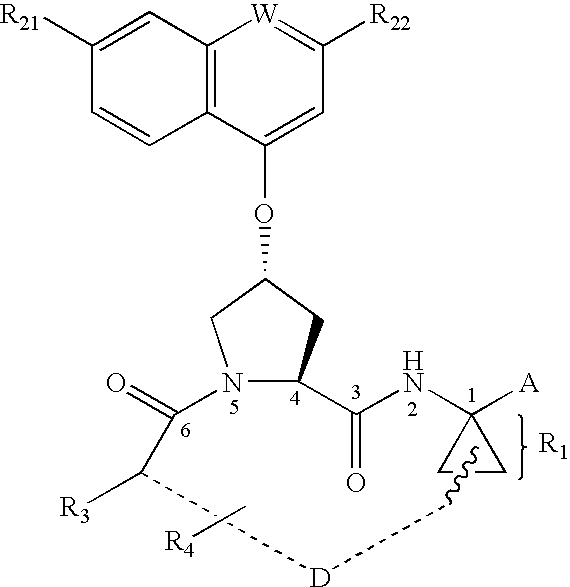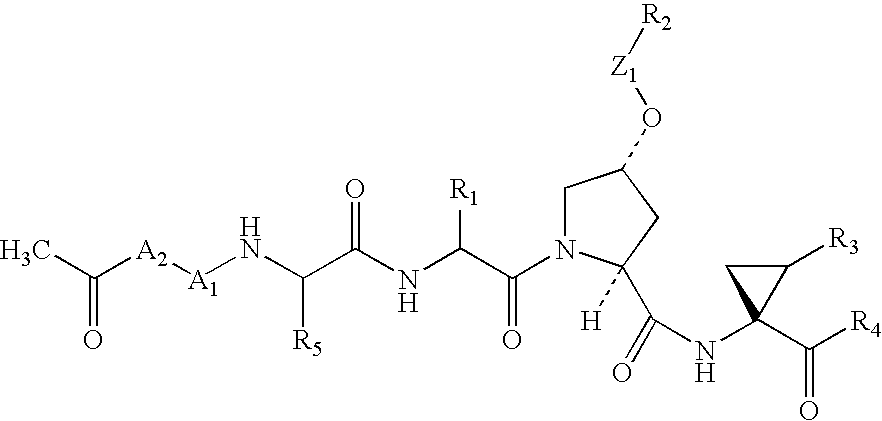Cyclobutenedione-containing compounds as inhibitors of hepatitis C virus NS3 serine protease
a technology of cyclobutenedione and protease, which is applied in the field of new hepatitis c virus (“ hcv”) protease inhibitors, can solve the problems of poor treatment effect of hcv infection, low sustained response rate of therapies, and frequent side effects
- Summary
- Abstract
- Description
- Claims
- Application Information
AI Technical Summary
Benefits of technology
Problems solved by technology
Method used
Image
Examples
example 100
PREPARATIVE EXAMPLE 100
Preparation of Compound of Formula 100 of Table I
[0258] Part I: Preparation of Amine of formula 100-1
[0259] To a 0° C. solution of commercially available N-t-BOC-L-Cyclohexylglycinol 100-2 (OmegaChem, Canada) (15 g, 62 mmol) in DCM (170 mL) and Pyridine (17 mL) was added dropwise methanesulfonylchloride (5.3 mL, 68 mmol, 1.1 equiv). After addition, the reaction was warmed-up to RT and stirred for 18 hours. The reaction was diluted with EtOAc and washed 2 times with 120 mL of ice-cold water then brine (100 mL). Organic layer was dried over MgSO4, filtered and concentrated down to provide 20.9 g of crude oil 100-3.
[0260] To a RT solution of 100-3 (3.4 g of crude) in DMF (7 mL) was added NaN3 (9.62 g) and the reaction was warmed-up to 65° C. After 5 hours, reaction was cooled down and diluted with EtOAc (100 mL) and ice-cold water (100 mL). After extraction, organic layer was washed water and with brine, dried over MgSO4, filtered and concentrated down to a...
example 106
PREPARATIVE EXAMPLE 106
Preparation of Compound of Formula 106 of Table I
[0271] Part l: Preparation of Amine of formula 106-1
[0272] Amine 106-1 was prepared according the procedure outlined in preparative example 100 by replacing in step 1 the commercially N-t-BOC-L-Cyclohexylglycinol 100-2 with the corresponding commercially available N-t-BOC-L-tert-Butylglycinol.
Part II: Preparation of Amine Salt of Formula 106-2.
[0273] Amine 106-2 was prepared according the procedure outlined in preparative example 100, part II by replacing in step 2 amine of formula 100-1 by amine of formula 106-1 described before.
Part III: Preparation of Compound of Formula 106
[0274] Compound of formula 106 was prepared following the procedure outlined in part IV of preparative example 100 by replacing amine 100-5 with amine salt 106-2.
[0275] HCV inhibitors 115, 121, 135, 147 and 148 described in Table 1 were prepared using intermediate of formula 106-1 according to the general procedures described ...
example 104
PREPARATIVE EXAMPLE 104
Preparation of Compound of Formula 104 of Table I
[0276] Part I: Preparation of Amine of Formula 104-3
[0277] To a solution of commercially available diethyl squarate 104-1 (Aldrich Chemical Co.,Milwaukee, Wis., USA, 1 g, 5.88 mmol) in THF (20 mL) at −78° C. was added t-BuLi (5.93 mmol, 3.5 mL) over a period of 30 seconds. After 50 min, 0.5 eq. t-BuLi was added to the reaction and stirring was continued for 60 min at −40° C. Then, TFAA (1 mL, 7.06 mmol) was added at −40° C. dropwise. After 10 min, 10% NH4Cl (aqueous) (10 mL ) was added. The resulting solution was warmed to RT and poured into a mixture of Et2O (50 mL) / 5% NaHCO3 (aqueous) (80 mL). The aqueous layer was extracted with ether. Combined organic layer was washed with brine then dried over MgSO4. After concentration to dryness, the residue was purified by HPFC, 25+M column with 5˜20% EtOAc in hexane as eluent to give 0.874 g product 104-2.
[0278] The procedure for the preparation of intermediate of...
PUM
 Login to View More
Login to View More Abstract
Description
Claims
Application Information
 Login to View More
Login to View More - R&D
- Intellectual Property
- Life Sciences
- Materials
- Tech Scout
- Unparalleled Data Quality
- Higher Quality Content
- 60% Fewer Hallucinations
Browse by: Latest US Patents, China's latest patents, Technical Efficacy Thesaurus, Application Domain, Technology Topic, Popular Technical Reports.
© 2025 PatSnap. All rights reserved.Legal|Privacy policy|Modern Slavery Act Transparency Statement|Sitemap|About US| Contact US: help@patsnap.com



